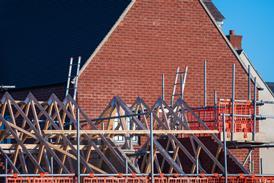Last year, NVB won BD’s Education Architect of the Year Award. Here, practice director James McGillivray expands on the practice’s mantra: if you don’t understand people, you cannot design for them

The way we work has evolved over a number of years rather than through a single declaration or manifesto, and often we are too busy to consider it consciously. When challenged recently, we found that we were clumsy in articulating our ethos, preferring to let the drawings do the talking. Winning BD’s Education Architect of the Year was, therefore, a welcome prompt to step back and consider how we work and what we believe in.
Architecture shapes space for its (usually human) inhabitants. Of course, the critical point is the quality of that shaping—the consideration of volume, proportion, touch, colour, and texture—but if you don’t understand people, you cannot design for them. This applies equally whether you are designing smartphones, trousers or, in our case, buildings and landscapes.
This goes beyond just ergonomics. It is about how people experience the building, how they feel about it. Do they move through it with ease? Is the play of light comfortable and inviting?
It goes further than aesthetics. Of course, buildings have to meet regulations, and they are there to guide us and to keep people safe, but sometimes, to use the well-worn saying, the law is indeed an ass. Why should we stick rigidly to the British Standard when we know that there is always a queue snaking down the corridor from the women’s loos at any cinema, concert, or sports event you could mention?
And as for those ridiculous “Part M compliant” mirrors in accessible WCs, which span the minimum height required by the Approved Document and not a millimetre more, as if compliance means sticking strictly to those dimensions. It seems perfectly obvious that it is possible to meet those needs but also make the mirror slightly taller so that someone standing can see in it too. At a push, it might even be possible to consider proportion and elegance.
There have been many great examples of heroic architecture throughout history, but they rarely make great learning environments
A slightly flippant point, but it touches on the wider issue of how we design for a society with vastly diverse experiences of life, almost certainly different from our singular viewpoint. Clearly, as diverse a pool of architects as possible can help with this, and those of us in leadership positions have a responsibility to encourage diversity in every way possible. Having a design review with people with very different life experiences from our own team can be hugely positive for design quality, but what about situations where this is not possible? Few architecture studios are large enough to create a truly representative team for every single commission.
This is where the importance of humanity in our work comes in: we need to develop our listening and empathy skills, our sense of curiosity and humility, taking careful note before wielding our pencils. We need to be brave in saying, “Tell me about that.” Ignorance is not an insult if we are honest and seek to address it.
We should always remember that clear design leadership and vision are critical parts of the role of the architect, but our education is never finished. Curiosity, questioning, and tenacity are all aspects of leadership. One of the projects in our winning entry for the Architect of the Year Awards required over a year’s consultation with Historic England to reach the final scheme, and we genuinely believe it is the better for it. It added an extra level of rigour to the process in having to justify both our client’s requirements and our design decisions. It is the polar opposite of Trumpian courtroom bludgeoning.
>> Also read: What made this project… Haberdashers’ Boys’ School by NVB Architects
There have been many great examples of heroic architecture throughout history, but they rarely make great learning environments, comfortable homes, or restorative hospitals. It would be awful for architecture to lose any sense of theatre, but it must be shaped around the experience of the visitor, resident, or pupil. We are all familiar with the loveless mausoleum, as parodied so brilliantly in the Unhappy Hipsters Tumblr feed all those years ago. I am sure I was not the only one who felt a twinge of discomfort when scrolling through the soulless images of people sitting awkwardly in painfully non-human houses.
Roland Barthes wrote a beautiful short essay on toys, in which he describes how wood suits toys compared to other materials, the way it wears slowly over time rather than shattering like plastic toys, and the warmth of its touch. I think about this all the time when selecting materials for our projects. We want our schemes to look great when they are new and get better with age, but even more than that, we want our projects to feel great—to be welcoming where we touch, to be hard where they need to be, and to be planted where they can.
Our specialism is in education, and it is always pleasing to see how subtle changes in finishes, acoustics, light, air, and planting in playgrounds can have such a radical impact on pupil behaviour and happiness.
Winning the award has been a wonderful validation for our whole team and the way we approach our work. We were not party to the judges’ thought process, but it seems no coincidence that all of the projects we submitted took a holistic approach to inside and outside, architecture and landscape, blending the two disciplines in which we practise. Ultimately, we see this award as a recognition of the many fruitful creative relationships we have forged with a wide range of clients, engineers, makers, user groups, consultees, and other collaborators, which result in better places.
Postscript
James McGillivray is a director of NVB Architects
















No comments yet